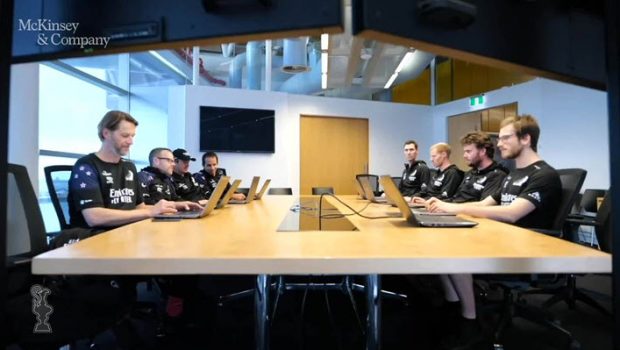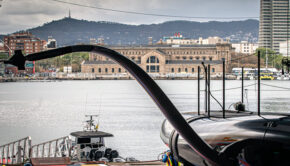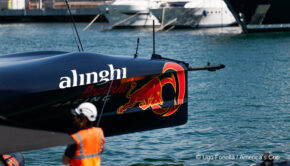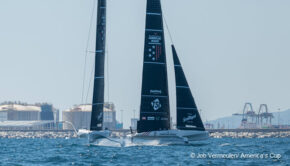How technology won the America’s Cup
Published on March 17th, 2021
The Little Blue Book Of Sailing Wisdom quotes 3-time America’s Cup winner Dennis Conner as saying, “Design has taken the place of what sailing used to be.” In this report by McKinsey & Company, they describe just how Emirates Team New Zealand defended the America’s Cup by utilizing a new crewmember: an AI bot created by McKinsey:
Winning the America’s Cup has always been as much about technology and innovation as it is about sailing. Boat designs are governed by the competition’s “Class Rule” which leaves small opportunities for design tweaks that might give one team an advantage over another.
Those opportunities, if brilliantly seized, can translate into a shining race-day performance.
The AC75 Class Rule for this year’s race, published in March 2018, was not your typical sailboat. Hydrofoils fixed to the hull lift the entire craft out of the water, enabling it to reach speeds exceeding 60 mph.
Most importantly, the hydrofoils are one part of the boat where the Class Rule allows for design modifications, which offer huge competitive advantages for the teams that get those modifications right.
Doing so, according to McKinsey senior partner Brian Fox, requires intensive testing—and lots of it. “Every boat in the America’s Cup is designed with a computer simulator,” says Fox, who sails competitively. “Whichever team has the best simulator, and uses it most effectively, gains the advantage.”
In 2019, Emirates Team New Zealand partnered with McKinsey to begin an innovative project seeking that advantage. What they needed, they soon realized, was a new kind of crew member that could sail thousands of boats at a time. The answer to that call was an AI bot, or software robot, that could test new hydrofoil designs by sailing them on Emirates Team New Zealand’s simulator.
The simulator had been key to the team’s victory in 2017; the sailors had used it to test new boat designs without having to actually build them. But that simulator required multiple team members using it simultaneously for it to work properly. This was a logistical challenge, given the sailors’ scheduled practices, travel, and competitions.
“Our goal,” Fox explains, “was to speed up testing of Emirates Team New Zealand’s designs. By developing an AI bot that could run the simulator by itself, we no longer had to manage around the sailors’ limited availability.”
As a first step, the McKinsey team, which included colleagues from their analytics firm QuantumBlack, turned to the cloud. Over six-weeks, data, analytics, and machine-learning experts from Sydney, Melbourne, and London migrated New Zealand’s simulator and developed an infrastructure to run it in the cloud.
Then their team used a new and innovative approach called deep reinforcement learning to essentially teach the AI bot how to become a professional sailor. The technique allowed the bot to learn dynamically and gain greater accuracy through continuous feedback.
Nic Hohn, one of the key project leaders, explains. “When you start, the AI agent knows nothing and learns by trial and error using countless variables—wind speed, direction, adjustments to the 14 different sail and boat controls—and is refined again and again,” Hohn says. “Since the bot keeps experimenting, if you coach it to learn in the right way, it compresses into hours what would take a human years to understand.”
The work was highly technical, according to QuantumBlack’s chief scientist Jacomo Corbo, and it required extensive innovation around the bot’s learning program. “At this point in the project, a lot of creative thinking had to be done to figure out the right learning models, how best to coach the bot, and the right guard rails and rewards to put into place.”
The team also created a network that allowed multiple bots to share information as they each learned to sail. This was a critical breakthrough, as it allowed the individual bots to gain knowledge from their collective experience. Ultimately, there were a thousand bots running in parallel, learning from each other.
“It’s learning at a huge scale and it dramatically reduces the time and cost of the project,” says Hohn. “That’s the power of the cloud.”
Within two weeks, the bot was sailing in a straight line, upwind and downwind. After mastering the basics, it graduated to more complex sailing maneuvers.
The turning point came about eight weeks later, when the AI bot started beating the sailors in the simulator. At this point, the bot became the ideal way to test variations of the hydrofoils; it was more consistent and more scalable than the sailors, speeding the cycles of design iterations dramatically.
“This was the critical unlock—the ability to take the sailors’ schedules out of the equation and test designs 24/7 on rapid repeat,” observes Helen Mayhew, a McKinsey partner and member of the QuantumBlack leadership team in Europe, who is also a world champion sailor.
Soon, the sailors were learning maneuvers from the bot. “With such a steep development curve, accelerating the learning process is extremely valuable,” explains Oliver Fleming, an expert associate partner, “both in terms of allowing the design team to explore as much of the design space as possible and the sailors to maximize performance for a given design.”
Over the course of 2019 and early 2020, the bot sped New Zealand’s design process by a factor of ten. And, although the race is just about to kick off, this project has already proven that reinforcement learning can be a transformational tool for process design, with potential applications across industries.
“This is one of the most complex deployments of deep reinforcement learning in the public cloud,” says Corbo. “One way to think about the difficulty of the problem: game-tree complexity roughly tallies the size of the space one has to navigate while accounting for the set of possible game paths, or the sequence of decisions, that need to be taken.
“Go, which is an extremely complex board game, has a game-tree complexity of 170—our sailing problem has a game-tree complexity of nearly 2900.”
Mastering such technical complexity, particularly in this application, has heightened this singular project’s excitement for everyone involved.
“It is thrilling to be using technology and AI to master the wind and water and go as fast as you possibly can,” says Hohn. “This is not sailing as we know it—it’s much closer to flying a low-altitude aircraft.”
America’s Cup Match Scoreboard (wins-losses)
Emirates Team New Zealand (NZL): 7-3
Luna Rossa Prada Pirelli Team (ITA): 3-7
Advancing as the winner of the PRADA Cup, the Italian challenger faced the Kiwi defense in the best of 13 series. After the postponement due to government COVID-19 health regulations, the 36th America’s Cup Match racing schedule had two races per day planned for March 10, 12, 13, 14, 15, and each day after that until the first team had won seven races.
More information:
• America’s Cup format, standings, and how to watch: click here.
• Complete America’s Cup coverage: click here
• Additional America’s Cup information: click here









 We’ll keep your information safe.
We’ll keep your information safe.